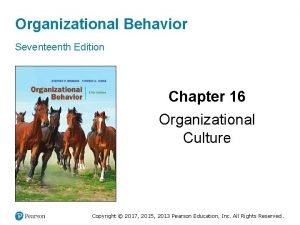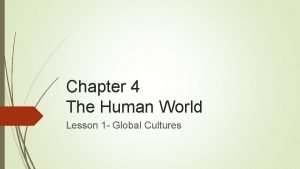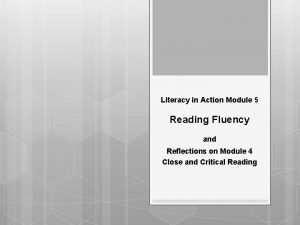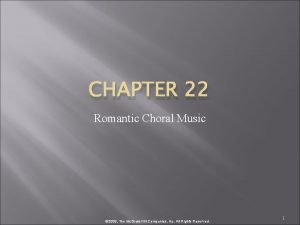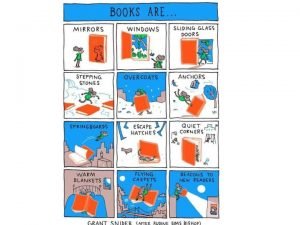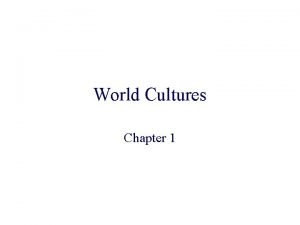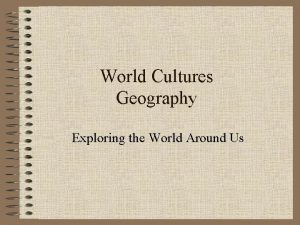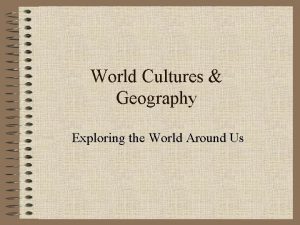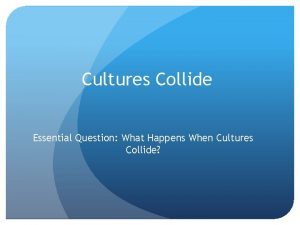Choral Cultures Around the World 1 Question Research






- Slides: 6

Choral Cultures Around the World 1. Question & Research Task SLIDE NAVIGATION 1 2 3 4 5 6 Next We are going to explore choral groups from around the world in order to determine how qualities of the music reflect culture. Some qualities we are going to focus on are: • Timbre • Tonal quality (rich, weak) • Function in culture ( religious, communication, narrative) • Texture (harmonics) • Scales (Major or Minor) • Cultural infusions (style, movement, unique traits) Your teacher/librarian will plan this You. Tube video celebrating 30 years of singers and choirs from all over the world. Image Source: https: //youtu. be/j. J 1 yo. TCf. Eeo In this Slam Dunk, you will conduct brief, focused research to respond to the inquiry question: How does the culture around you influence the way music sounds?

2. Information Sources SLIDE NAVIGATION 1 2 3 4 5 Choose several of the information sources linked here to complete the Student Activity on Slide 3. Country/Culture Information Sources Middle Eastern Pletenitsa Balkan Choir- Padna Magla Philippines Novo Concertante Manila African • Stellenbosch University Choir, South Africa • Mukuni Choir Bulgarian Le Mystere des Voix Bulgares- Ergen Deda Norwegian Cantus- Vuelie Russian Lux Aurumque performed by Gnesins Ensemble German Vienna Boys’ Choir- Mozart’s 250 Anniversary American Harlem Gospel Choir- Amazing Grace Korean Yonsei University Concert Choir- Canto Latino Hong Kong Diocesan Boys School Choir Czech Republic Ondrášek Czech Choir- Salve Regina Venezuelan Niños Cantores de la Orquesta Sinfónica Juvenil y Camerata Larense British Cantamus Girls Choir- Remember Me 6 Next

3. Student Activity SLIDE NAVIGATION 1 2 3 4 5 6 1. Download the note taking organizer. 2. Pick 3 different culture choir groups that you identify with personally. 3. Watch the video information sources for each country/culture. 4. As you are watching take notes on the following qualities of the music you are listening to: • • • Timbre Tonal Quality Function (religious, communication, community) Texture/harmonies Scale Cultural influences 5. You are going to transform this research into a comparison essay of your three chosen cultures. See the next slide for the Assessment Activity. Final Scene in Sister Act 2 with student performance Image Source: Sister Act 2, http: //viewpure. com/ROj. W 14 qtnu 0? start=1020&end=1295 Next

4. Assessment Activity SLIDE NAVIGATION 1 2 How does the culture around you influence the way music sounds? You can demonstrate your understanding in the form of n essay. Please include in your essay: • an introduction (1 paragraph) • an explanation of each of the choirs characteristics for each culture (3 paragraphs) • a comparison of their cultures and their differences (1 -3 paragraphs) • a conclusion describing what you found to be your favorite choir group, and why you consider them the “best” choir group based on the information you collected. Screen shot of Word Online. Final essays can be submitted and shared with your teacher through One. Drive. Image Source: support. office. com 3 4 5 6 Next

5. Enrichment Activities SLIDE NAVIGATION 1 2 3 4 5 6 Next One of the largest competitions for Choral music is the World Choir Games, considered to be “The Olympics” of Choir music. As you read the article on the left consider how your choral group might perform if asked to compete at the World Choral Games. Learn a little more about this non-professional choir competition and what would be involved to participate in the experience. Open this link and find our more about: South Africa's Kearsney College Choir competing at the 2012 World Choir Games, click on image to read article. Image source: https: //www. npr. org/2012/07/02/156115628/the-olympics-of-choralmusic-come-to-cincinnati , https: //www. interkultur. com/ • Would you qualify for the minimum requirements? • Which Competition would you want to compete in: the champions or the open competition? • Which category do you think looks interesting, or an ideal fit for your group? • What if you don’t want to compete, how can you still attend as a group? • Do you consider this to be only a choir competition or are there other elements to this event that could help you grow as a choral student?

6. Teacher Resources Learning Standards Alignment Maryland Fine Arts Standards for Music Anchor standard 8: Interpret intent and meaning in artistic work. Anchor Standard 10: Synthesize and relate knowledge and personal experiences wo make art. Anchor Standard 11: Relate artistic ideas and work with societal, cultural, and historical context to deepen understanding. SLIDE NAVIGATION 1 2 3 4 5 6 Chorus 9 -12 Objective: Students will be conduct brief, focused research of various choral groups of the World in order to determine how culture around you influences the sound quality of choral music. Time Frame: (2) 90 minute class periods Common Core State Standards for English Language Arts & Literacy Reading: 1. Read closely to determine what the text says explicitly and to make logical inferences from it; cite specific textual evidence when writing or speaking to support conclusions drawn from the text. Writing: 7. Conduct short as well as more sustained research projects based on focused questions, demonstrating understanding of the subject under investigation. AASL Standards Framework for Learners Inquire: Build new knowledge by inquiring, thinking critically, identifying problems, and developing strategies for solving problems. Think: Learners display curiosity and initiative by: I. A. 2 Recalling prior and background knowledge as context for new meaning. Create: Learners engage with new knowledge by following a process that includes: I. B. 1 Using evidence to investigate questions. I. B. 3 Generating products that illustrate learning. Share: Learners adapt, communicate, and exchange learning products with others in a cycle that includes: I. C. 1 Interacting with content presented by others. Notes to the teacher: • Collaborate with your school library media specialist to plan and implement this lesson. • Have students use learning supports provided in any BCPSlicensed Digital Content included in this lesson. Refer to Digital Content Snapshots & Support resources for guidance as needed. • Consider using the Schoology Assignment Apps feature to assign Microsoft and Google documents and files for students to access, edit, and submit through Schoology. • Teacher will need to screen all videos in this slam dunk or share through Voicethread or Safari. Grow: Learners participate in an ongoing inquiry-based process by: I. D. 2 Engaging in sustained inquiry. P 21 Framework: 21 st Century Student Outcomes 3. Information, Media & Technology Skills: Information Literacy: Access information efficiently and effectively; Use information accurately and creatively for the issue or problem at hand. ICT Literacy: Use technology as a tool to research, organize, evaluate and communicate information. Last updated: July 2020 Report broken links to BCPS Library Media Programs & Digital Resources 443 -809 -4035 BCPS Slam Dunk Research Model, Copyright 2018, Baltimore County Public Schools, MD, all rights reserved. This lesson may be used for educational, non-profit school use only. All other uses, transmissions, and duplications are prohibited unless permission is granted expressly. This lesson is based on Dr. Jamie Mc. Kenzie’s Slam Dunk Digital Lesson model.
